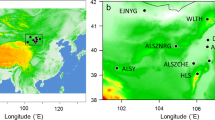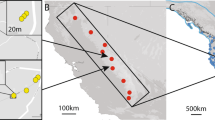Abstract
Although spatial analysis of population genetic structure has been one of the most important ways to infer microevolutionary processes, these studies are usually focused on neutral dynamics and limited dispersal, interpreted under the theoretical reasoning of isolation-by-distance. More recently, however, there has been a growing interest on how environmental variation is also involved in population differentiation, both by direct effects of local adaptation and other processes related to environmentally or ecologically constrained dispersal. Here we evaluated patterns of genetic population structure and isolation-by-ecology, or environment (IBE), in Eugenia dysenterica DC (Myrtaceae), a fruit tree species of economic potential interest and widely distributed throughout the Central Brazil and endemic to the Cerrado biome (Neotropical savannas). We analyzed population structure using nuclear SSR markers for 736 individuals sampled from 23 localities (local population) and disentangled the effects of genetic molecular variation, estimated by pairwise FST (matrix G) and geographical distances (matrix S) into Grinnelian niche of populations (matrix E), based on climate and soil data. Spatial patterns in eigenvectors of G and E reveal northwest-southeast gradients, coherent with geographic range shifts after the Last Glacial Maximum. We used different forms of Mantel regression and correlation and redundancy analyses, as well as simulations of isolation-by-distance, to show that there is a significant partial correlation between G and E taking S into account, thus supporting the IBE process for E. dysenterica, in addition to other processes related to spatially constrained gene flow.





Similar content being viewed by others
Change history
22 July 2022
Handling editor name correction.
References
Alvarado-Serrano DF, Knowles L (2014) Ecological niche models in phylogeographic studies: applications, advances and precautions. Mol Ecol Res 14:233–248
Anacker BL, Strauss SY (2014) The geography and ecology of plant speciation: range overlap and niche divergence in sister species. Proc R Soc B 281:20132980
Baack E, Melo MC, Rieseberg LH, Ortiz-Barrientos D (2015) The origins of reproductive isolation in plants. New Phytol 207:968–984
Balkenhol N, Waits LP, Dezzani RJ (2009) Statistical approaches in landscape genetics: an evaluation of methods for linking landscape and genetic data. Ecography 32:818–830
Barbosa ACOF, Collevatti RG, Chaves LJ, Guedes LBS, Diniz-Filho JAF, Telles MPC (2015) Range-wide genetic differentiation of E. dysenterica (Myrtaceae) populations in Brazilian Cerrado. Bioch Syst Ecol 59:288–296
Barton NH, Etheridge AM, Kelleher J, Veber A (2013) Genetic hitchhiking in spatially extended populations. Theor Pop Biol 87:75–89
Boaventura-Novaes CRD, Novaes E, Mota EES, Telles MPC, Coelho ASG, Chaves LJ (2018) Genetic drift and uniform selection shape evolution of most traits in Eugenia dysenterica DC. (Myrtaceae). Tree Genet Genomes 14. https://doi.org/10.1007/s11295-018-1289-2
Borcard D, Legendre P (2012) Is the Mantel correlogram powerful enough to be useful in ecological analysis? A simulation study. Ecology 93:1473–1481
Bradburd GS, Ralph PL, Coop GM (2013) Disentangling the effects of geographical and ecological isolation on genetic differentiation. Evolution 67:3258–3273
Diniz-Filho JAF, Bini LM (2012) Thirty-five years of spatial autocorrelation analysis in population genetics: an essay in honour of Robert Sokal (1926–2012). Biol J Linn Soc 107:721–736
Diniz-Filho JAF, Soares TN, Telles MPC (2014) Pattern-oriented modeling of population genetic struture. Biol J Linn Soc 113:1152–1161
Diniz-Filho JAF, Soares TN, Lima JS, Dobrovolski R, Landeiro VL, Telles MPC, Rangel TF, Bini LM (2013) Mantel test in population genetics. Gen Mol Biol 36:475–485
Diniz-Filho JAF, Barbosa ACOF, Collevatti RG, Chaves LJ, Terribile LC, Lima-Ribeiro MS, Telles MPC (2016) Spatial autocorrelation analysis and ecological niche modelling allows inference of range dynamics driving the population genetic structure of a Neotropical savanna tree. J Biogeogr 43:1167–1177
Epperson BK (2003) Geographical genetics. Princeton University Press, Princeton
Funk DJ (2009) Investigating ecological speciation. In: Butlin RK, Bridle JR, Schluter D (eds) Speciation and patterns of diversity. Cambridge University Press, Cambridge, pp 195–218
Guillot G, Rousset F (2013) Dismantling the Mantel tests. Meth Ecol Evol 4:336–344
Guillot G, Leblois R, Coulon A, Frantz AC (2009) Statistical methods in spatial genetics. Mol Ecol 18:4734–4756
Hardy OJ, Vekemans X (1999) Isolation by distance in a continuous population: reconciliation between spatial autocorrelation analysis and population genetics models. Genetics 83:145–154
Harrison RG, Larson EL (2014) Hybridization, introgression, and the nature of species boundaries. J Hered 105:795–809
Huang J-P (2020) Is population subdivision different from speciation? From phylogeography to species delimitation. Ecol Evol 10:6890–6896
Hernández-Hernández T, Miller EC, Román-Palacios C, Wiens JJ (2021) Speciation across the tree of life. Biol Rev 96:1205–1242
Holsinger KE, Weir BS (2009) Genetics in geographically structured populations: defining, estimating and interpreting FST Nat Rev Genet 10:639–650
Legendre P, Fortin M-J (2010) Comparison of the Mantel test and alternative approaches for detecting complex multivariate relationships in the spatial analysis of genetic data. Mol Ecol Res 10:831–844
Legendre P, Legendre L (2013) Numerical ecology, 3rd edn. Elsevier, Amsterdam
Leigh DM et al (2021) Opportunities and challenges of macrogenetic studies. Nat Rev Genet 22:791–807
Lichstein J (2007) Multiple regression on distance matrices: a multivariate spatial analysis tool. Plant Ecol 188:117–131
Lima-Ribeiro MS, Varela S, González-Hernández J, Oliveira G, Diniz-Filho JAF, Terribile LC (2015) EcoClimate: a database of climate data from multiple models for past, present, and future for macroecologists and biogeographers. Biodiv Inform 10:1–21
Manly BFJ (1997) Randomization, bootstrap and Monte Carlo methods in biology. Chapman and Hall, London
Meirmans PG (2012) The trouble with isolation-by-distance. Mol Ecol 21:2839–2846
Nosil P, Harmon L (2009) Niche dimensionality and ecological speciation. In: Butlin RK, Bridle JR, Schluter D (eds) Speciation and patterns of diversity. Cambridge University Press, Cambridge, pp 127–154
Oden N, Sokal RR (1992) An investigation of three-matrix permutation tests. J Classif 9:275–290
Orsini L, Vanovebeke J, Swillen I, Mergeay J, De Meester L (2013) Drivers of population genetic differentiation in the wild: isolation by dispersal limitation, isolation by adaptation and isolation by colonization. Mol Ecol 22:5983–5999
Pearse DE, Crandall KA (2004) Beyond FST: analysis of population genetic data for conservation. Conserv Gen 5:585–602
R Development Core Team (2021). R: a language and environment for statistical computing. R Foundation for statistical computing, Vienna, Austria. ISBN 3–900051–07–0, URLhttp://www.R-project.org. .
Rieseberg LH, Blackman BK (2010) Speciation Genes in Plants. Annals Bot 106:439–455
Rieseberg LH, Willis JH (2007) Plant speciation. Science 317:910–914
Rousset F (1997) Genetic differentiation and estimation of gene flow from F-statistics under isolation-by-distance. Genetics 145:1219–1228
Schluter D (2001) Ecology and the origin of species. Trends Ecol Evol 6:372–380
Sexton JP, Hangartner SB, Hoffmann AA (2013) Genetic isolation by environment or distance: which pattern of gene flow is most common? Evolution 68:1–15
Shafer ABA, Wolf JBW (2013) Widespread evidence for incipient ecological speciation: a meta-analysis of isolation-by-ecology. Ecol Letters 16:940–950
Seehausen O, Butlin RK, Keller I, Wagner CE, Boughman JW, Hohenlohe PA, Widmer A (2014) Genomics and the origin of species. Nature Rev Genet 15:176–192
Sokal RR, Jacquez GM (1991) Testing inferences about microevolutionary processes by means of spatial autocorrelation analysis. Evolution 45:152–168
Stankowski S, Ravinet M (2021) Defining the speciation continuum. Evolution 75:1256–1273
Telles MPC, Coelho ASG, Chaves LJ, Diniz-Filho JAF, Valva FD (2003) Genetic diversity and population structure of Eugenia dysenterica DC. (“cagaiteira” – Myrtaceae) in Central Brazil: spatial analysis and implications for conservation and management. Conserv Genet 4:685–695
Telles MPC, Diniz-Filho JAF, Coelho ASG, Chaves LJ (2001) Autocorrelação espacial das freqüências alélicas em subpopulações de cagaiteira (Eugenia dysenterica DC., Myrtaceae) no sudeste de Goiás. Rev Bras Bot 24:145–154
Telles MPC, Silva JB, Resende LV, Vianello RP, Chaves LJ, Soares TN, Collevatti RG (2013) Development and characterization of new microsatellites for Eugenia dysenterica DC (Myrtaceae). Genet Mol Res 12:3124–3127
Wagner HH, Fortin MJ (2013) A conceptual framework for the spatial analysis of landscape genetic data. Conserv Genet 14:253–261
Wang IJ (2013) Examining the full effects of landscape heterogeneity on spatial genetic variation: a multiply matrix regression approach for quantifying geographic and ecological isolation. Evolution 67:3403–3411
Wang IJ, Bradburd GS (2014) Isolation by environment. Mol Ecol 23:5649–5662
Wiens JJ (2004) Speciation and ecology revisited: phylogenetic niche conservatism and the origin of species. Evolution 58:193–197
Wright S (1943) Isolation by distance. Genetics 28:114–138
Zucchi MI, Brondani RPV, Pinheiro JB, Chaves LJ, Coelho ASG, Vencovsky R (2003) Genetic structure and gene flow in Eugenia dysenterica DC in the Brazilian Cerrado utilizing SSR markers. Genet Mol Biol 26:449–457
Zucchi MI, Pinheiro JB, Chaves LJ, Coelho ASG, Couto MA, Morais LKM, Vencovsky R (2005) Genetic structure and gene flow of Eugenia dysenterica natural populations. Pesq Agrop Bras 40:975–980
Acknowledgements
Thanks to Ivan Scotti and two anonymous reviewers for their comments on previous versions.
Funding
Our research program in population genetics of Cerrado plants has been supported by the project “Núcleo de Excelência em Genética e Conservação de Espécies do Cerrado”-GECER (PRONEX/FAPEG/CNPq CP07-2009), by the several grants and fellowships to the research network GENPAC (“Geographical Genetics and Regional Planning for natural resources in Brazilian Cerrado”) from CNPq/MCT/CAPES/FAPEG and by the National Institute of Science and Technology (INCT) in Ecology, Evolution and Biodiversity Conservation (CNPq/FAPEG). Fieldwork for these two projects have been continuously supported by Systema Naturae for Environmental Consultant by JAFDF, MPCT, LCT, and TNS; and LJC is also supported by productivity grants from CNPq.
Author information
Authors and Affiliations
Corresponding author
Ethics declarations
Conflict of interest
The authors declare no competing interests.
Data archiving statement
Data are provided as Supplementary information.
Additional information
Communicated by K. Heer
Publisher's note
Springer Nature remains neutral with regard to jurisdictional claims in published maps and institutional affiliations.
Supplementary Information
Below is the link to the electronic supplementary material.
Rights and permissions
About this article
Cite this article
Diniz-Filho, J.A.F., Soares, T.N., Chaves, L.J. et al. Isolation-by-ecology in a Neotropical savanna tree. Tree Genetics & Genomes 18, 23 (2022). https://doi.org/10.1007/s11295-022-01555-w
Received:
Revised:
Accepted:
Published:
DOI: https://doi.org/10.1007/s11295-022-01555-w




